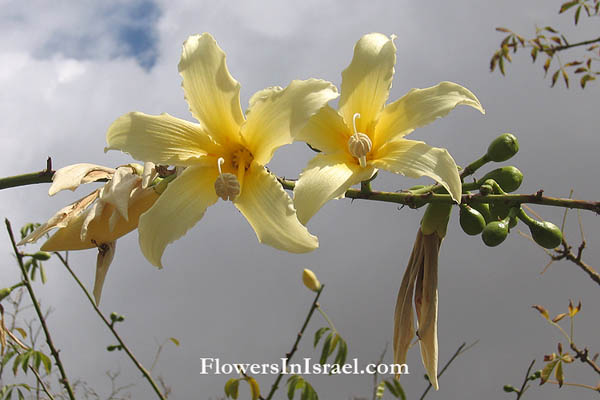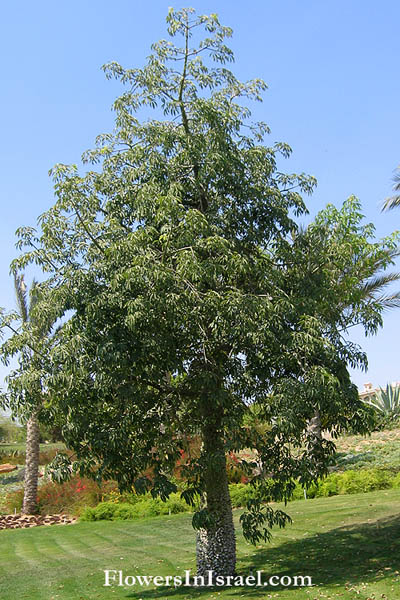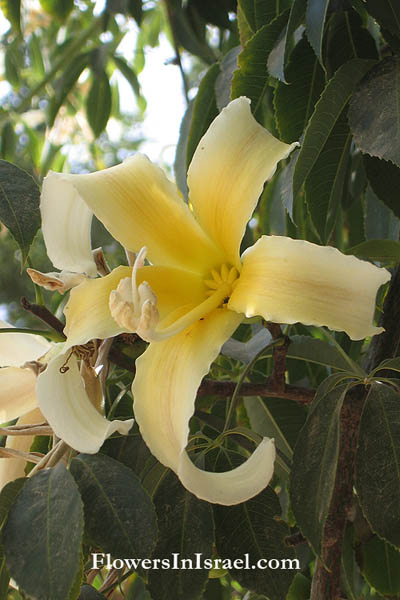"כוריזיה בקבוקית ,"העץ השיכור
| Scientific name: | Chorisia insignis Kunth | |
| Synonym name: | Ceiba insignis (Kunth) P.E. Gibbs & Semir | |
| Common name: | White Silk Floss Tree | |
| Hebrew name: | כוריזיה בקבוקית ,העץ השיכור | |
| Family: | Malvaceae, Subfamily: Bombacoideae, בומבקסים |

|
| Life form: | Deciduous tree over 12m high | |
| Stems: | Erect; the trunk becomes bottle shaped as it ages, and it is covered with stout spines; the spine is conical in shape, measuring 1–2 cm in width at the base and 2–3 cm in length, with stiff pointed apex and brownish surface with longitudinal fine ridges; the main spines are carrying smaller ones with pointed apices varying from very minute microscopically to larger visible sizes | |
| Leaves: | Alternate, compound palmate, petiolate; palmate of 7 leaflets; each is oblong-obovate with symmetric base measuring 5–8 cm long and 1.5–3 cm wide with a short petioleole | |
| Inflorescence: | Solitary | |
| Flowers: | White to creamy yellow lily-like flowers | |
| Fruits: | Pear shaped capsules, containing a silky floss coming out of the seeds | |
| Flowering Period: | April | |
| Origin: | Southern Brazil, Argentina |

Derivation of the botanical name: Chorisia, named for Ludwig Choris (1795–1828), a botanical artist, who sailed around the world with the Russian navigator, Otto von Kotzebue (1787–1846). insignis, distinguished, remarkable. Ceiba, comes from the Taino, the original inhabitants of these islands. In English, the tree is often called the "kapok tree", though it has had many other names in many cultures.
Christopher Columbus in 1492, and Gonzalo Fernandez de Oviedo (1478–1557, a Spanish historian and writer), in 1526, were both impressed by the size of the canoes that the Indians in the West Indies and coastal Central and South America made from the Ceiba tree. These canoes (another Taino word) were hollowed out of tree trunks all in one piece. (The Taínos were the pre-Columbian indigenous inhabitants of the Bahamas, Greater Antilles, and some of the Lesser Antilles) The Taino used the huge trunks of tall ceibas to make the large canoes, which they used to travel from island to island. The first report of them comes from Christopher Columbus, who wrote, on his first voyage to the "New World": On every island there are many canoes of a single piece of wood; and though narrow, yet in length and shape similar to our rowboats, but swifter in movement. They steer only by oars. Some of these boats are large, some small, some of medium size. Yet they row many of the larger row-boats with eighteen crossbenches, with which they cross to all those islands, which are innumerable, and with these feats they perform their trading, and carry on commerce among them. Isaw some of these canoes which were carrying seventy and eighty rowers... 
|